The Muscle-Up


The muscle-up is a skill that is essentially a pull-up followed by a dip. It is used to take yourself from below a sets of rings or bar to above a set of rings or bar. Many can do a pull-up, and many can do a dip, but transitioning between the two takes a certain level of strength and coordination.
I’m going to go over the technique for each muscle-up variation, then explain certain progressions at the end.
The Muscle-Up on Rings
Let’s start by examining the muscle-up on rings. If you need a pair of rings yourself, there are a great pair of wooden ones over at RubberBanditz.
Anyways, it all starts off with something called the false grip. The false grip is simply a way of grabbing the rings that places the wrist above the ring rather than below it. With the wrist above the ring, the transition into the dip becomes easier.
 |
 |
| Normal Grip | False Grip |
You want to put your wrists on the rings, and then flex your hands towards your elbow and towards your pinky fingers. If you are hanging from the rings in a normal grip already, then try to place your hands one at a time into position by flexing the wrist and getting it set up in position.

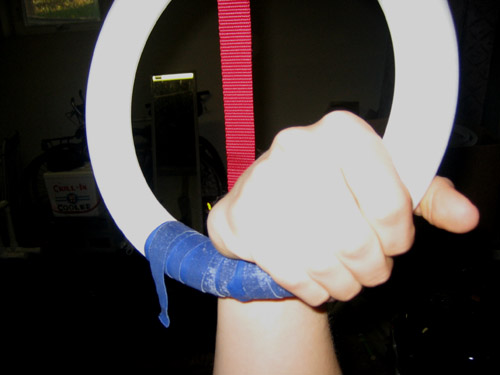
This hand position is fairly difficult to hold when you first try it. I would suggest working false grip body rows (feet on the ground, lean back and pull your chest up to the rings) or false grip chin-ups for some time to build up your strength and confidence in the hold.
And yes, it always feels a bit uncomfortable on the wrists.
Do I have to use the false grip?
No, you don’t have to use the false grip. You can use a normal grip on the rings, you’ll just have to use your legs and kick more. This can cause a bit of swinging on the rings though and I generally don’t like to do it.
The pulling technique (see below) is still the same, you’ll just have to kick your legs up a bit more. If you have trouble with the kicking as well, scroll on down to the discussion under “muscle-up on a bar”.
It’s my opinion that you should try and learn the false grip on the rings immediately, even if you have to kick your legs like hell to get to the top. There’s no point in building up the pulling strength to do a muscle-up, then having to build up the strength to hold a false grip. Do both at the same time.
Now that you’ve got the false grip down, it’s time to work on the pulling technique. We’ll start off with the false grip and hands above your head at shoulder-width. With the false grip it becomes more difficult to fully straighten your arms, but try as much as you can. In the pictures below, it’s the ring height more than anything that’s keeping me from a full arm
extension.

As you start to pull yourself upwards, try and bring the rings inwards and keep them in front of you and close to the chest and body. Doing so will help with the transition when you are first learning the skill.
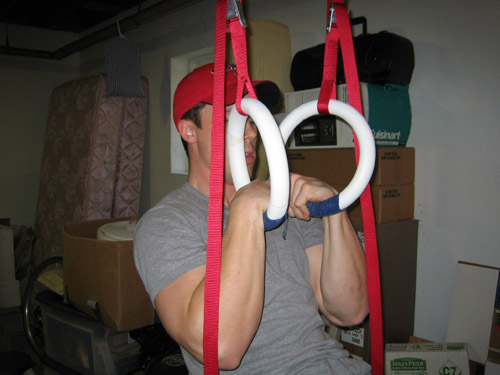

Now that you have the rings at your chest, it’s time to transition to the dip. As you keep the rings close together and in close to the body (with a false grip!) the most important thing to think about is getting your shoulders (i.e. your weight) over your hands. This is done by leaning forward and soon as you can. I call it a “roll” because it should feel a bit like your shoulders are rolling from behind the rings to over top of them.
You could pull hard enough to put your shoulders a foot above the rings, but if you don’t lean forward and get your weight over your hands, you’ll fall right back down.
During this time you’ll want to try and turn the rings to the outside. Your hands will start to split apart to shoulder-width in preparation for the dip, but don’t let them go out too far! So the rings go from in-between your hands to the outside of your arms.
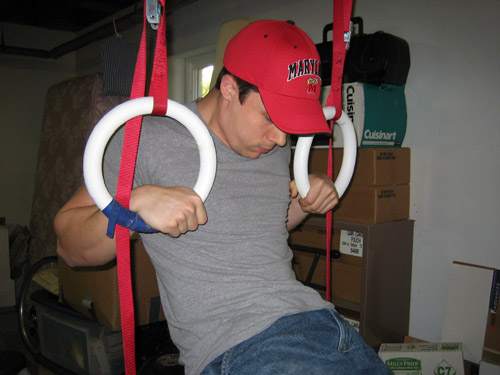
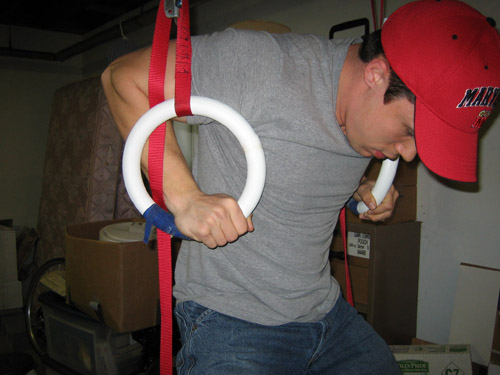
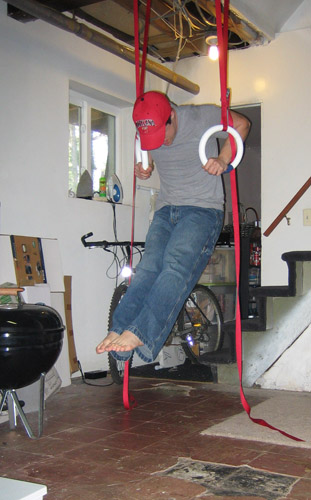
The legs are also an important part of the muscle-up. You can see in the picture that I am bent slightly at the hips with my feet out in front of me slightly. Even with a slow, controlled muscle-up, you’ll need some of your lower body in front of the rings. You can keep the legs straight like I do, or just lift the knees up in front of you.
The reason for this is to allow the body weight to shift slightly so that you can get behind and eventually over the rings. After you’ve gotten your shoulders over your hands and are pressing into the dip, the legs will naturally drop right underneath your body again.
Hopefully you’ve kept things tight and rolled enough to find yourself at the very bottom of a dip. It’s a simple push to a straight arm support from here.

When you become stronger in the ring muscle-up, your hands won’t need to stay in the center of your body quite as much and you won’t need to lean forward as much (if at all). It will become a pull-up straight into a tricep pushdown with your entire bodyweight. My hands tend to be about shoulder-width the whole time now when I’m doing muscle-ups and I still lean forward a bit.

The strongest, slowest, and smoothest ring muscle-up I’ve seen is by Andreas Aguilar at the 1991 World Professional Gymnastics Championships. No extraneous movement, no kicking, just a pull.
The “ooo’s and aaahhh’s” from the crowd are well deserved.
In case the video is removed from Youtube, here’s some shots from the video.



As you can see, Andreas starts in a false grip, raises his legs slowly (offering no assistance), keeps his torso perfectly vertical, and pulls with his hands far from his body.
The Muscle-Up on a Bar
The muscle-up on a bar can be done in several ways which I’ll explain below. We’ll continue where we left off from the ring muscle-up and first talk about how to do the muscle-up slowly. This is the harder variation.
If you need a solid pullup bar setup, check out RubberBanditz for their pullup bar and parallette superset!
Slow and Steady
I first heard about the slow muscle-up through John Gill’s website where he lists the achievements of his friend and fellow climber, Pat Ament. Besides an excellent one arm handstand (22 seconds) and several difficult press to handstands, John recounts that Pat could perform a slow muscle-up on a horizontal bar. He then added the note – “harder than it sounds”. The slow muscle-up on the bar is a grinding skill – just like a controlled muscle-up on the rings.
And just like a controlled muscle-up on the rings, you’ll want to start off with a false grip on the bar. On the squat rack where I often do pull-ups, there are handles and the hands are very easily set-up. I simply have to flex my wrists and place my hand on the “ledge” that exists (see picture below).


Close-up of false grip
On a bar, you’ll have to flex your wrists, point the hands inwards, and place as much of your hand and wrist on top of the bar.

Note that while it may look similar, this is not the same grip as in the no-handed one arm chin. For the bar muscle-up, you’ll want your hands and wrists in front and on top of the bar.
With this hand position, now just pull down and raise yourself up and over the bar. Just like the muscle-up on the rings you’ll want to bring your legs out in front of you slightly and try to lean your shoulders over your hands as soon as you can. As I said with the ring muscle-up, you may bring up your entire legs, or just your knees.
I suppose on this variation, as with the ring muscle-up, it’s possible to lift slowly like Andreas Aguilar. Kudos to you if you can manage a slow muscle-up on the bar with no lean.
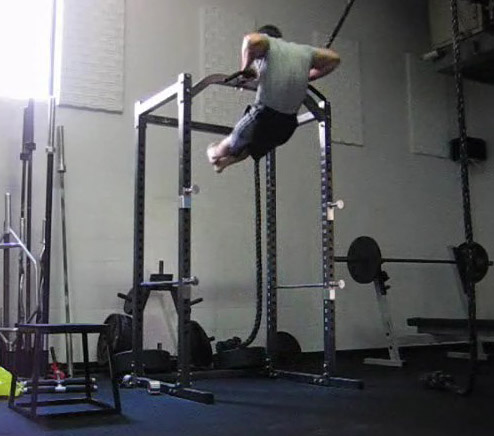
And as strange as this sounds, make sure you pull the bar down in front of you. More about that in the next section. Go slow and controlled, bring both elbows up and over the bar at the same time and you’ll be in the bottom of the dip in no time. Also make sure to wrap your thumbs around the bar as soon as you can so that your hands don’t fall off the bar.
Going out Kicking and Swinging – The Fast Muscle-Up
At this point you may be thinking “these muscle-ups are too hard! what else can I do??” Well, adding a bit of kicking and swinging to these muscle-ups can help tremendously in getting you up and over the bar or rings.
Now the additional of a kick or swing falls in the grey area between a progressive skill and a skill in and of itself. This is because the kicking and swinging is certainly a progressive way of working up to a slow, controlled muscle-up, but a muscle-up with a kick and a swing can still be very technical and difficult in it’s own right.
Kicking
Now you’ll need a bit more speed and pop than the previously described muscle-ups. Another difference is that you don’t have to use a false grip anymore. Just grab the bar in a normal pull-up position (palms turned away).
.jpg)
One of the most important parts about this dynamic muscle-up on a bar is the way you do the pull-up. Just like the slow one, you have to pull the bar down in front of you so that you go behind the bar. If you pull yourself up and under the bar, you won’t make it over.
The difference-

Pulling up under the bar = wrong

Pulling up behind the bar = right
So as you pull-up, try to keep your elbows about shoulder-width apart. Keep your hands away from your body by keeping the arms only partially flexed. If you find yourself pulling the bar to your upper chest and failing to make it up and over, then you’re probably flexing your arms and pulling your elbows back too much instead of keeping the bar out in front of you.
The legs at this point are going to kick up in front of you. You’ll want to coordinate this with your pull so that both the leg kicking and the arm pulling work together to get you up and over the bar. Just like the muscle-up on rings, you’ll be bending at the waist and either putting your knees or straight legs out in front of you.
I prefer the straight legged version as you can generate more power and a greater lift. How is this so? Well, just think if you were swinging a baseball bat. You’ll generate a lot more power swinging a three foot bat as opposed to a two foot bat.
With the legs, another thing to consider is holding the legs or knees up slightly after you’ve kicked up with them. In other words, maintain a slight bend at the waist. Just like in the ring muscle-up, this will allow your bodyweight to more easily shift over the bar.
Below is a picture of a muscle-up with a huge kick. You can choose to kick more or less.

After you’ve pulled yourself up high enough, then you want to lean forward and pull the bar to your hips. This lean is essential, as it gets your weight over the bar and flips your elbows over in preparation for the dip. Speaking of elbows, flip both over at the same time! Nothing looks uglier than a struggle to flip one elbow over, then the other one. Some may argue that it’s a good progression to flip the elbows over the bar one at a time, but I believe it just enforces bad habits and can be a bit jarring on the shoulders.
This is also the part where your wrists are going from below the bar to above the bar. Make sure the wrists are getting over the bar as you are pulling downwards. If they don’t get over the bar, you may be high enough, but when your weight settles back down you’ll just fall back down.

Get the wrists over the bar!
While putting together this tutorial, I inadvertently took two pictures illustrating exactly what I mean about the wrists. They are from the two pictures just up the page illustrating a pull-up behind the bar, and a muscle-up with a kick. Notice the pull-up picture:

I was pulling up high (my shoulders are well over the bar) but I was not trying to do a muscle-up. In this case notice how my wrist is still under the bar.
Compare that to the muscle-up with a kick picture:

Here my wrist is above the bar (and I’m leaning as well). This will get me over the bar.
With a strong pull, hard kick, and a quick lean in to the bar, you’ll find yourself at the bottom of the dip. Push it on out to finish.




Swinging
You can also employ a slight swing in order to help yourself up and over the bar. At this point, the line between muscle-up and another gymnastics move – the kip – is starting to blur. I think the swing is a really drastic technique to use for the muscle-up. One should try to get stronger and out grow the need for a swing.
With a swing into a muscle-up, you’ll want to swing forward under the bar with your arms straight, then wait until you swing back as far as you can go before you pull yourself up and over the bar. If you pull too early then you’ll still be under the bar (problem) and won’t get the maximum amount of lift that swinging provides (problem). If you pull too late, then your bodyweight will be falling downwards, which won’t help the skill.
Below is the reverse muscle-up and a gigantic swing –

Swing out far

Pull when you are at the back and top of the swing.
So picture the quarter-circle that your body is traveling in the swing and just make sure you’re at the very back of it.
The Reverse Muscle-Up
I first heard about the reverse muscle-up from Jack Arnow, and the skill greatly intrigued me. Such a simple change in variation but what a difference it makes!
The reverse muscle-up (or reverse grip muscle-up) is simply a muscle-up with a supinated grip (palms facing you) rather than a pronated grip (palms away, or the regular muscle-up just described).

Is this harder? Definitely. The pull felt awkward to me at the beginning, but the mechanics are very similar to the regular muscle-up. You want to pull down and in front of the body as much as you can.
Because you are not able to take a pronated false grip, I don’t know if there’s any way to do this skill slowly. Swinging into the skill made it very easy, but I was also able to do it with just a hard kick with no swing at all.

The big thing you’ll want to remember is to keep the bar away from you! Think about keeping the arms just slightly bent until you’re high enough and can lean and dive into the bar. An early pull inwards with the arms will get you stuck under the bar. So if you find your hands at your stomach and your torso leaning backwards, then you’ve gotten yourself stuck under the bar.

Careful doing this skill. With the way the arms are situated and the lean needed, my legs always had a tendency to swing back really high as I was pressing out at the top.

And to answer the oft-asked question, yes – everyone in my gym thinks I’m a nutcase…
One trick I’ve found that helps to flip the hands over easier is to slightly extend at the wrists as you grab onto the bar. It doesn’t seem like much of a difference, but I found that shifting the wrist like this reduces the distance it has to travel around the bar. It helps me.

Hands and wrists in common position when doing a chin-up.
Trouble when doing the reverse muscle-up.

Wrists are slightly shifted to help the wrists get over the bar.
With this slight shift in wrist position make sure you’re pulling with the fingers and not the thumbs. I always found it impossible to do a reverse muscle-up when the pulling pressure was on my thumbs. I’ll assume this is due to the simple fact that the thumb is not as strong as four fingers! Power for the reverse muscle-up was obviously being lost. So if you find the pressure is on your thumbs, just shift the wrists back slightly until you feel the pull on your fingers.
Progressions and Exercises
I’ve already mentioned kicking and swinging into a muscle-up. This makes any muscle-up easier and should be used when you’re first learning the skill. Eventually you should decrease the swing or kick and try to get rid of it entirely.
Steps
The use of steps or the ground can help the muscle-up by allowing one to assist with the legs and jump off the ground. If you have a set of steps then simply use lower and lower steps as you get stronger. This way, the legs are stretched out more and more and produce less and less force to assist in the muscle-up. Force that the arms must now produce.

If you have a set of adjustable rings, then it’s simply a matter of adjusting the height of the rings to suit your needs.
The steps are also less technical than a kick or swing, and so ideally suited when first starting out. Nearly everyone has jumped up and climbed over a wall, so the feeling is fairly familiar.
Feet on Blocks
This assistance method is similar to a method one can use for learning a regular chin-up. Instead of jumping, kicking, or swinging into the skill, simply put your feet on a bench or box and perform a muscle-up as normal.

The box serves to take some weight away from the arms and make the muscle-up easier. You can adjust the height of the box/bench (or just use the ground) as well as the amount of bend in your legs to increase or decrease the assistance provided.

Remember muscle-up technique though and make sure you are pulling up behind the rings and not under them. Focusing on keeping the hips bent at a 90 degree angle can help keep your body in the right position. If your hips rise up too high and you start leaning backwards then you’ll get stuck under the rings and won’t be able to roll your shoulders forward.
Weighted Chin-ups/Pull-ups and Dips
Is there anything that weighted chin-ups/pull-ups and dips won’t do? In my opinion, working these exercises heavy is the best thing you can do in pursuit of any of the muscle-ups listed. Some may say that just working one half or another won’t help in building up strength for the transition.
I say if you’re strong enough to do a pull-up with 100 extra pounds, then pulling your own bodyweight right past the transition point will be easy, even if you’ve never practiced it before! You will be so strong and the pull will be so fast that you’ll fly right through!
So get yourself off the lat pulldown and get a good dipping belt and some chain. A weightlifting belt will work, or you could try Ironmind’s dipping belt. I’ve recently been fortunate enough to add it to my training equipment and it works very well. Comfortable around the hips, yet strong with no fear of breaking.
Negatives
Getting yourself up to the top any way you can, then dipping down and falling back into a hang has limited use when first training for the muscle-up on the bar. It will help to show you roughly where your arms should be during the skill. The problem is that when you first start you’ll naturally drop right through the sticking point and therefore it is not much for building strength in the position. It’s also a bit jarring on the joints to free fall and then stop yourself in the pull-up position.
When you can do a slow controlled muscle-up, feel free to come back down again slowly and pull right back up. But again, when working towards your first muscle-up, stay away from negatives on the bar.
Now negatives for the muscle-up on rings are a bit more helpful. Due to the nature of the apparatus, you can keep the rings tight up against your body and work the muscles through the full range of motion.
The tricky part of this is dropping down into a false grip. As the rings go from the outside of your body to the inside of your arms and against your chest, you’ll want to flex your wrists toward your elbows and try to get the wrists on the rings – in other words, into a false grip. With any luck, you’ll find yourself hanging from a false grip position at the bottom.
.jpg)
Warnings
Shoulder issues can definitely arise from the muscle-up due to the hyper-extension of the shoulder at the top of the movement. If you have problems doing dips in general, but especially low dips, then watch yourself carefully. You may have to forego the skill entirely.

If this hurts you, be careful with the muscle-up!
Conclusion
The muscle-up doesn’t look too hard on first look. But those who try it quickly realize it’s a difficult skill that really tests your pulling strength. There are many ways to work the skill and get yourself over the bar, but if you become strong enough to pull up slowly, then you’ll truly understand how the muscle-up got its name.
Best of luck. Train hard.


Thanks for this tutorial, some of the best description of how to perform the muscle up I’ve read.
Thanks man. We were at a family reunion and were trying to figure out how to get over the bar!
I sent your article out to everyone who was at my family reunion. We made a standing challenge for Easter. First one to muscle up wins. :)
Please make video tutorials!
Thanks for a great explanation on how to do a muscle up. I plan to give this a try tomorrow when I hit the gym. I tried it a month or so ago and couldn’t get it but didn’t use your form. It will also help that I lost about 5 pounds in the last month.
I’ve been trying to get the muscle-up for ages, but couldn’t figure it out. Turns out (for me at least) that it’s all in the wrists. The picture you had of the grip with the wrists flexed inwards made all the difference! So, I managed to do my first one today (after an extended break from chin-ups as well). Wasn’t the prettiest, but it was quite good for a first try. It was a big accomplishment for me and I just wanted to say thanks :)
u are all fucken steroid users with small ass dicks
When you first started using the rings, and a false grip, were your palms becoming bruised and sore? An u doing something wrong?
Man, I was pulling under the bar :/
Great tutorial ! There aren’t hundreds of them, but each of them is well done/written.
Thanks, I’ve never heard the tip about putting the legs forward. Sounds like it will help a lot.
Really nice tutorial!
Do I keep my elbows tucked into my side almost to make sure I get out in front of the bar on the muscle up? So like if someone is standing in front of me my elbows are pointing at them? Or elbows pointing out at a sort of 45 degree angle? Cause I get pretty high, but I feel I am to far under the bar to adjust my wrist and go into the straight bar dip.
45 degrees. It’s the scapular plane.
Really informative tutorial, much appreciated!
But im wondering, what about high explosive chest pullups as a progression for the MU?
Thanks, all the best!
Those work great too!
Awesome tips, thanks for this! I was approaching these completely wrong.
Cool blog! Is your theme custom made or did you download it from somewhere?
A design like yours with a few simple tweeks would really make my
blog jump out. Please let me know where you got your design.
With thanks
Getting behind the bar versus under the bar made all the difference for me! Thanks for the crucial tip!
I’m having trouble pulling behind the bar. How how you not flex the arms while doing a pull up? Being a tall guy, I cannot really keep my legs straight for the kip, so that prevents me from using my legs to get behind the bar as well. Any suggestions?
Great tutorial. Very informative and precise. Thank you.
Thank you so much for the tips! It took me 9 months of practice after first visiting your site but I finally got my first muscle-up on the rings today. Once I had it I did about 10 more – they seemed pretty easy all of a sudden. I’m not kipping or kicking but I do have to start with a slight bend in my elbows; I can’t yet do it with a straight pull out of a dead hang. That will come soon though as I can already do two muscle-ups consecutively without breaking the hold or touching the floor. It has been a mental challenge as much as a physical one. I have some tips to pass along to all the other frustrated folks out there who have trained and trained like me but can’t quite get this skill.
What finally helped me over the top were three things: First, a strong false-grip is essential. I thought I had it but about three weeks ago I realized I was cheating it and could hold it only with bent elbows, so I went back to basics and trained my false grip in dead-hangs with straight elbows off the bar and then the rings till I could hold it with palms facing outwards for 20-30 seconds. Wrapping my wrists with hockey tape covered my blisters and sore calluses and gave me further confidence in the hold. The tape plus gripping tightly with the fingers also prevented slippage of my hands off the top of the ring.
Second was the realization that the first part of the pull has to come from the back muscles, with a conscious effort to tilt the head and torso backwards as you begin the pull. I figured this out as I was practicing a strict knees-to-bar with my elbows locked. Just pulling with your back like a shrug gives you the first few inches of elevation to help initiate an explosive movement upwards as the arms kick in. This technique also gives you the correct torso positioning to allow a pull with the rings in front of you as described in the section on performing muscle-ups on a bar.
Third, I trained the muscle memory needed for the all-important transition move by scaling the skill with rubber bands. Holding each end of a band under the false grip and then sitting on the band allowed easy pulls through the transition to the dip. I started with the wide green band, then moved down to the narrower purple band and finally to the skinny black band, which provided minimal assistance out of the seated hang. I progressed through all three bands in just 2 weeks and could do 8-10 consecutive band-assisted muscle-ups with the black band by the time I ditched the band today and finally performed the skill on my own.
At age 45 I’m fairly athletic and fit but am not particularly muscular nor am I super strong, so I think that will give others hope. For comparison, I can do 15-20 bar chinups on a good day and 7-10 deep ring dips but I never was able to bench press much more than 225 lbs. Also, at 6’4, 195 lbs with long, long arms I thought anatomy was working against me ever getting a muscle-up. Not true!
So thank you again for your tutorial and I hope my suggestions help others master this essential Beast Skill. I’m proud to have finally gotten it!
Regards,
Jack
Jack,
Congratulations! All very excellent pieces of advice. I always say the top two things stopping people from their muscle-ups is lack of false grip strength, and incorrect shoulder position (not set down).
Good luck with your training!
-Jim
Just saw a guy doing these last night at the playground and thought, “Hmm, I wonder if that is a muscle up”? Looks fun–he was kicking pretty big. Can’t wait to give it a try. Thanks for this really detailed explanation.
No problem! They have become much more popular these days with the advent of CrossFit – and this is good!
Very useful tutorial. I have just got started trying muscle ups. Seems impossible at the moment but I know with time it will come. I like the box idea that seems like a sensible progression.
IFITISTOBEITISUPTOME
JOHN
Hi Jim,
Since my last post when I finally got the rings muscle-up I have worked very hard on the bar skill this summer. I have found the bar surprisingly difficult to master. Finally it came together today, so thanks again for your invaluable instruction. I thought I’d share my experience to hopefully help fellow strugglers like me.
In trying to make progress in my training, I vacillated between the strict version and the kipping/swinging techniques. With the false-grip I seemed not to be able to generate the elevation to do it strictly, yet I also found that my arm joints could not tolerate the dynamic loads generated by the swinging version. And it always felt like I was pulling out of a deep, deep hole when I tried to work the swing – I was just nowhere near able to get hips-to-bar, let alone chest-to-bar. My kip/swing was wonky and needed a lot of work.
Then I figured out that I could scale the strict muscle-up as a progressive skill by using rubber bands, as I did to learn the rings skill. I clipped a big carabiner to each end of the band and hung the carabiners off each side of the pull-up bar at the top of the squat rack – exactly like the rack you use in your tutorial. Climbing up the rack enabled me to get into a sitting position on the suspended rubber band. Lowering down into the start position of a pullup and then pulling up with band assistance made the higher pulls and the dip transition achievable and I was doing assisted bar muscle-ups immediately. So I kept working this skill and progressing through thinner bands till I realized today that I had developed a pretty decent chest-to-bar on an unassisted pull-up (with the bar well in front of me – essential, as you point out!). My false grip had really strengthened too in the past couple of months, which has helped a lot on the bar and the rings. So today I attacked the skill with confidence and performed several unassisted bar muscle-ups. As with anything physical, the mental piece is huge.
But here’s a tip that some may find helpful – this was a key discovery for me: I elevate my legs in a semi-pike as I come up and then near the top of the pull I actively spot my feet as I drop my legs down. I find that by consciously looking to my feet as my legs come down it really helps me rapidly rotate my upper body forward around my centre of mass, thus throwing my elbows and shoulders up and over the bar into the dip.
So I guess it’s not totally strict form but now I at least I have the confidence to work on that. More importantly, as with the rings, I can now integrate bar muscle-ups into my regular circuit training. Thanks again Jim!
Regards,
Jack
(P.S. I’m making steady progress on the ring levers.)
Awesome insights! Thanks for sharing!!